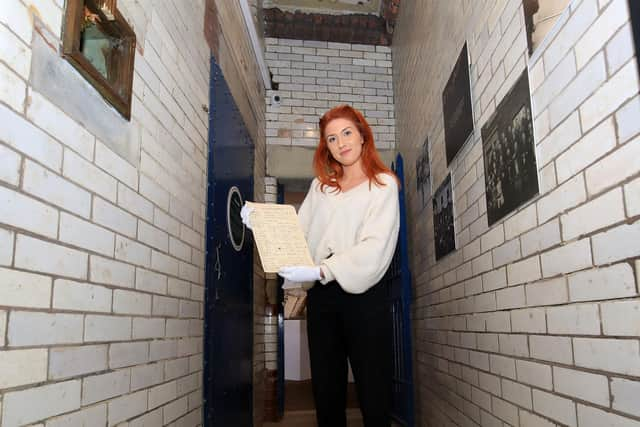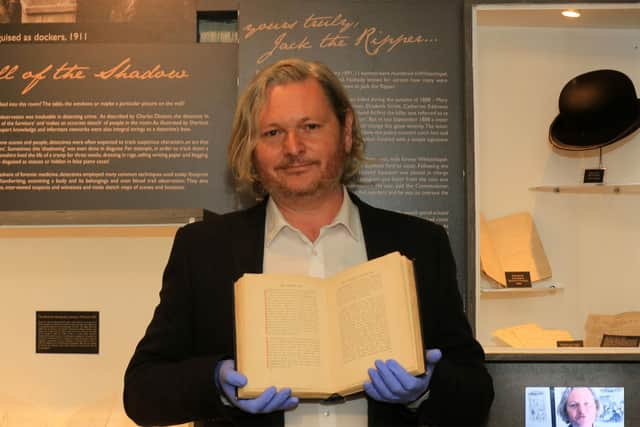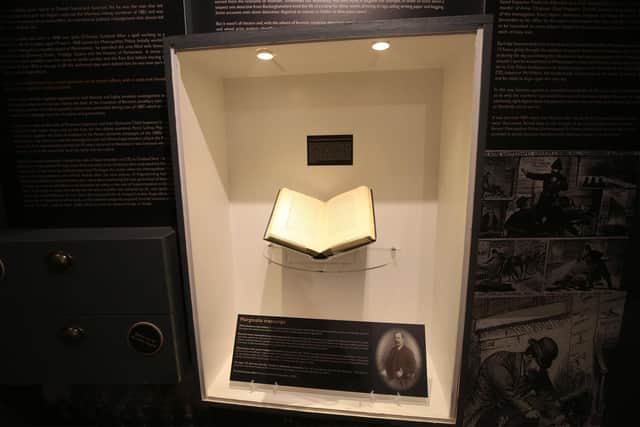Treasure trove of personal archives belonging to detective who led hunt for Jack the Ripper go on display at Sheffield museum
and live on Freeview channel 276
The private collection of Metropolitan Police Chief Inspector Donald Sutherland Swanson has been entrusted to the National Emergency Services Museum in Sheffield by the former detective’s family.
The treasure trove lay undiscovered for decades until Swanson’s descendants discovered an enormous collection of over 150 individual objects; paperwork, photographs, letters, drawings and personal belongings that shed light on the detective's heroic work solving crime all across the world during the Victorian era.
Advertisement
Hide AdAdvertisement
Hide AdAmong them was what became known as ‘the Swanson marginalia’; a book, annotated by Swanson, in which he names the person he believed to be the infamous killer, Jack the Ripper.


The marginalia, along with other items from the collection, will form part of a new exhibition, Daring Detectives & Dastardly Deeds, which will be revealed to visitors when the museum reopens on Wednesday, May 19.
Holly Roberts, curator at NESM, said: “This vast collection tells us an enormous amount about what it was like to be a detective in 19th century Britain. Even more unusually, there is so much of his professional career and his family and personal life, offering us a unique picture of what a prominent 19th-century detective did in his work time and his downtime. It is an amazing addition to our museum and to our new exhibition.”
The Swanson collection is thought to be one of the most detailed and significant of its kind. It includes official police paperwork and documents from a number of national criminal cases as well as Swanson’s own personal findings, theories and evaluations, arrest lists and the resources he used to solve some of the cases.
Advertisement
Hide AdAdvertisement
Hide AdDonald Sutherland Swanson joined the Metropolitan police force as a constable in 1868 and patrolled the streets of the capital, whilst also travelling far and wide as his career developed, later becoming Det. Superintendent of the Criminal Investigation Department in 1896.


He was a heroic detective during the Victorian era, solving many challenging cases across the world, and his stories are being brought into the public eye for the first time.
Adam Wood, the executive editor of Ripperologist magazine and author of the definitive biography of Swanson, helped to secure the collection for NESM.
His book titled ‘The life and times of a Victorian detective’ details the life and career of the Donald Sutherland Swanson, focusing on stories about Railway murders, grave robbers and the intriguing case of the Whitechapel murderer, Jack the Ripper.
Advertisement
Hide AdAdvertisement
Hide AdAdam said: “During my seven years of research into Donald Swanson's, life I realised that he had enjoyed an amazing career, much more than just his known involvement in the Jack the Ripper investigation.


“The 35-year period of the late Victorian era in which Swanson served was one of massive development for the Metropolitan Police, culminating in the dawn of fingerprint detection – perhaps more than anyone, it was he who epitomised the evolving Victorian detective, representing that era in the force’s history.
“Although a modest man, he was feted in the national press of the day as one of the country's best detectives – and indeed he rose to become Superintendent of the CID at Scotland Yard, the top detective in the country – so it's astonishing that he is largely unknown today, whereas contemporaries such as Frederick Abberline are familiar names.
“From the discovery of the archive in the early 1980s, the Swanson family have sought proper recognition of their ancestor's achievements, so it has been a joy bringing this to fruition by working with the National Emergency Services Museum to make the Donald Swanson collection accessible to all.”
Advertisement
Hide AdAdvertisement
Hide AdSpeaking about how the collection ended up at the museum, he said: “On the back of my article about the marginalia, I was introduced to the Swanson family and asked if they had any other material that I could look at to build up the story. They presented about four or five boxes full of papers, photographs and all sorts of things.
"To be honest, I don’t think they really knew what they had; they knew there were lots of papers related to important Victorian crimes, which are now forgotten about but were really important at the time.
“With my background and interest in Victorian crime, I knew what a lot of the documents related to, all the letters that had gone from the home office to Scotland yard, and I was able to sort of piece together a chronology of all this collection.
“During my seven years of research, one thing the Swanson family had said to me was that they’d love this collection to be on public display for everyone to understand more about his career, so it was a no-brainer. They were very happy as soon as Holly from The National Emergency Services Museum approached them for it to go on loan here for this exhibition; that’s how it came about.”
Advertisement
Hide AdAdvertisement
Hide AdHe added: “Ever since the discovery in 1980, they wanted more recognition for Donald Swanson's career, so I’m pleased that firstly the book enabled me to do that and give a true story to Swanson away from just that marginalia, and also the fact that the objects which were previously in a dusty box in a cupboard are now available for everyone to come and see.
“It’s also quite nice that it’s outside of London really because Swanson as a Scotland yard detective had the remit to go anywhere in the world, certainly not just in the UK but many other countries that had an extradition treaty with England. He could go to Egypt and arrest someone, which he did, so the Victorian detective and Swanson’s part is not just a London based story; it’s a whole Victorian era.
“Certainly, some of the pieces that will be on display are crimes that took place inside the country, and one of the documents relates to a major incident which took place in South Africa, nearly resulting in the first world war. Swanson arrested the perpetrators of that, brought them back to England, went down the Thames on a boat, met them off the ship and arrested them all to bring back up to Bow Street court. That’s a major incident and one of the things that is on display here at the museum is the subpoena for that case, the Bow Street magistrates court telling Swanson that he is required as a witness in this and it names all the perpetrators of this incident; it’s called the Jameson Raid, and that’s here on display at the moment.”
Bill Swanson, a great-grandson of Donald's, said: “It is clear from writings by his colleagues that he was held in the highest regard, and this is a source of great pride to the family.
Advertisement
Hide AdAdvertisement
Hide Ad"In particular, of course, there is the notorious case of 'Jack the Ripper'. It needs to be remembered that the Whitechapel case was, at the time, just another of the many crimes to be investigated by Swanson and the Metropolitan Police.”
As well as forming part of the museum’s new exhibition, NESM is also planning to digitise the collection and make it more widely accessible to researchers and historians.
It is looking to begin several research projects around the Swanson archive in partnership with researchers and colleagues to understand what can be learnt from the collection and will be hosting a series of workshops, talks and special events to celebrate the Donald Swanson story.